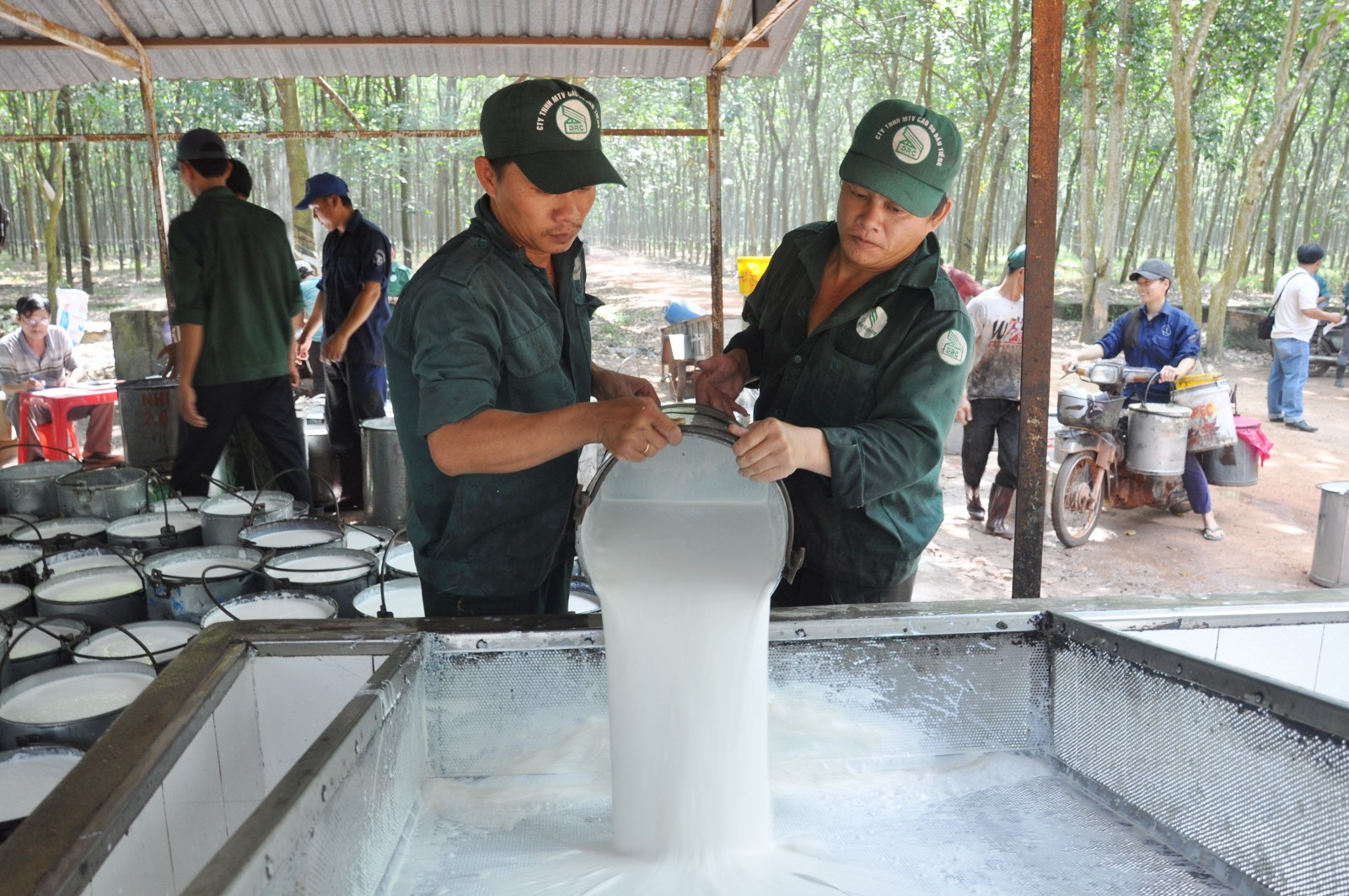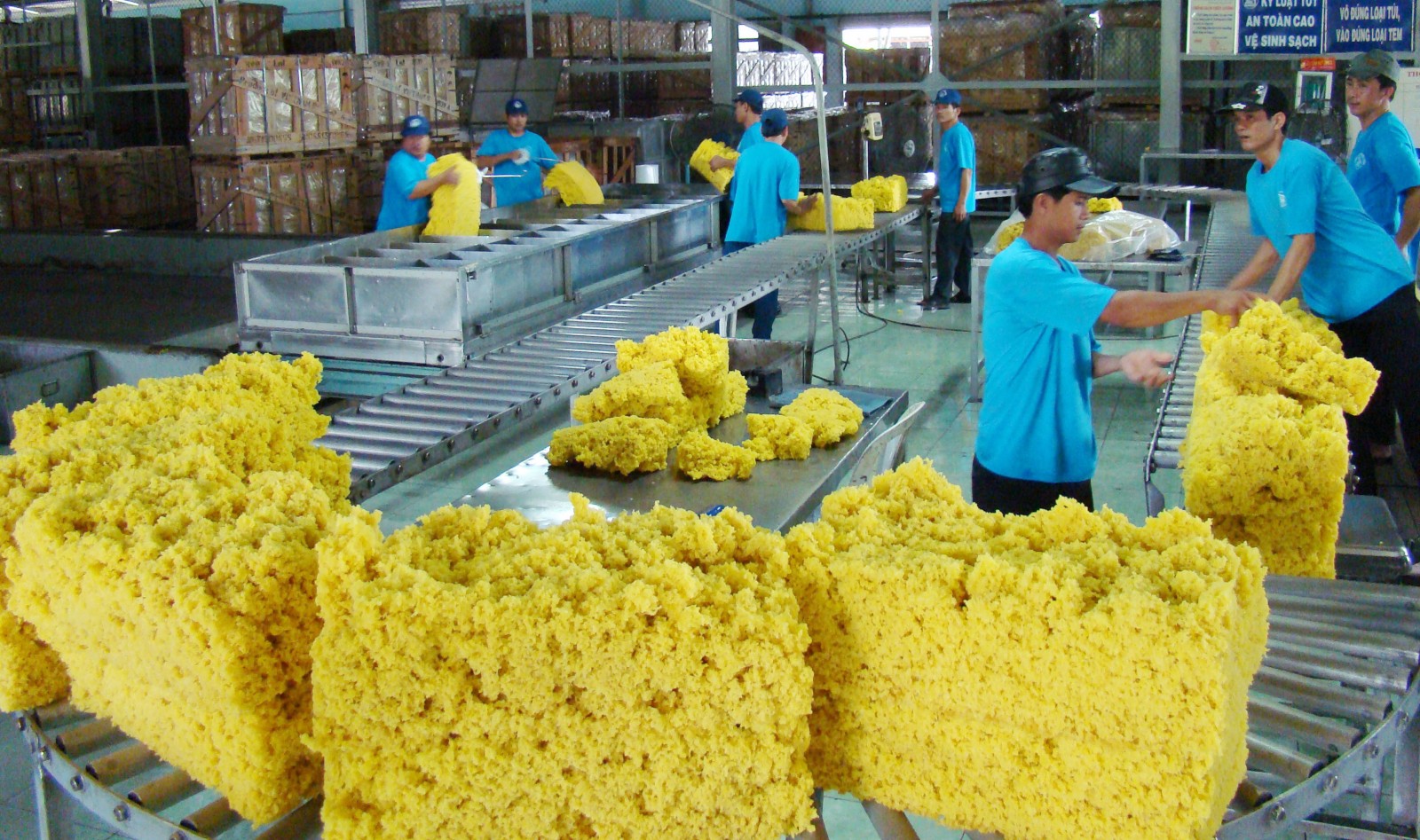Cleaner production in rubber industry cost reduction associated with environmental protection
Cleaner production (CP) is now an urgent need in industrial production, especially in the mining and processing industries such as rubber. Not only improving production efficiency, cleaner production is also an effective solution in the efficient use of natural resources, improving the health of workers and facilitating sustainable development.


Rubber production at Dau Tieng Rubber Company.
Double benefits
Cleaner production is meaningful for all industrial establishments, large or small, consuming more or less raw materials, energy, and water. At present, most businesses have the potential to reduce the amount of fuel consumed by 10-15%. With the aim of raising businesses' awareness of cleaner production, and at the same time improving the economic and environmental performance of enterprises, provincial Center for Trade Promotion and Industrial Development assessed clean production at Ben Suc Rubber Factory under Dau Tieng Rubber Company.
Practical evidences show that cleaner production brings not only economic benefits but also environmental benefits for industrial production. These benefits can be summarized as follows: Improve production efficiency; more efficient use of raw materials, water and energy; reuse valuable semi-finished products; reduce pollution; reduce treatment and disposal costs of solid waste, waste water and emissions; improve occupational health and safety. Regarding Ben Suc Rubber Factory, the application of cleaner production has been and will be conducted more and more effectively, in order to deserve to be a pioneer in application of cleaner production in the province in particular, the whole country in general, and in rubber manufacturing and processing. The CP team collected a flow chart of the production process, then identifies the inputs and outputs for each stage. Then, collected data from the company's reports on production practices, the data was tracked and recorded daily. At the same time, conducting a field survey to identify the inputs and outputs of each stage, through which the diagram can be adjusted. The survey combined with photos to illustrate production stages and to identify CP opportunities.
In this method, data were made by observing, monitoring and measuring at the site through experiments. The experiments in all fields of natural sciences, physics, mathematics, chemistry were conducted in the laboratory, outdoors... The CP team directly collected initial data and information from the observation of components, elements, events, activities at the research facility; reassessed the collected information; collaborated with the factory to collect missing or inaccurate information.
During the implementation process, the team also assessed the current situation of raw material, energy consumption, and identified the company's emissions, identified and proposed CP options for the company for application to reduce emissions and improve production process. Accordingly, in recent years, the factory has applied many measures to prevent, reduce and treat environmental pollution from production activities such as: Constructing a standardized wastewater treatment system, reusing wastewater within the production process and reusing wastewater after treatment; technology improvements... Besides, the factory carried out energy audits to identify and implement many energy-saving solutions. The overall summary shows that the consumption of raw materials at Ben Suc Rubber Processing Plant was efficiently.
The CP team consists of representatives of different departments and companies in the company who are interested in CP. With the scale of the current factory, the CP team has a role of both direction and implementation. The company is rewarded for suggestions on improvements and practices. The factory organized competitions among groups, rewarded workers who perform well the annual program.
In general, the environmental protection is well implemented by the factory at all stages of production, the production environment is clean. There is also a waste water treatment system at the factory. Gas from kilns is treated, factory is high and airy. The factory builds a safety culture, gives priority to preventive measures, ensures labor safety associated with environmental protection. The factory needs to participate more closely with workers to disseminate legal knowledge about occupational safety and health, implement and ensure good occupational safety and health to have the best working environment, contributing to improve productivity and efficiency.
In terms of energy consumption, the location of electricity substations for the factory is relatively good. The transformer stations in each cluster are located close to each other, thus reducing the voltage drop on the line, stabilizing and improving the quality of power supply. The electricity distributed at downstream is stable to meet production demand.
To propose many solutions
The CP team presented productivity and production data of the factory to give a specific overview to make evaluation. The group also proposed low-cost or no-cost investment solutions for the coming time as follows: The factory should continue to apply energy-saving solutions as proposed in its energy audit report; uphold 5S slogans, encourage productivity increase; regularly conduct inspections and maintenance to fix leaks on water pipes; improve workers' awareness; replace rusty and old equipment and devices of measuring electricity and water energy for every ton of products in each production workshop.
Besides, the team also proposed solutions to recover capital quickly and with high efficiency. Within the scope of the report, the CP team built up 5 integrated projects for the proposed solution. The main content of these 5 integrated projects is in-depth investment in machinery and equipment to diversify products in the factory on the basis of making full use of the capacity of machinery, equipment and the entire existing facilities. This allows the factory to minimize investment cost and improve project feasibility.
In particular, the solutions focus on the successful implementation of the national goal of "Cleaner production and energy saving." In addition, it also raises employees' awareness of practicing thrift, especially to help the community understand that resources are finite. In order for cleaner production to be widely applied at industrial production facilities to improve the efficiency of using natural resources, minimize emissions and curb the increase of pollution, protect and improve environmental quality.
Reported by Khai Anh - Translated by Ngoc Huynh
 Six-house cooperation supports farmers to increase the value of agricultural products
Six-house cooperation supports farmers to increase the value of agricultural products
 Ips achieve key targets ahead of schedule
Ips achieve key targets ahead of schedule
 Enterprises promote cooperation in green transformation
Enterprises promote cooperation in green transformation
 Digital technology applications to create breakthroughs in production and business
Digital technology applications to create breakthroughs in production and business
 People, enterprises as subjects, goals...
People, enterprises as subjects, goals...
 Management elevated to tackle tax revenue loss
Management elevated to tackle tax revenue loss
 Some new points of Decree 128/2024/ND-CP amending and supplementing trade promotion activities
Some new points of Decree 128/2024/ND-CP amending and supplementing trade promotion activities
 Solving challenges, promoting auxiliary industries
Solving challenges, promoting auxiliary industries
 OCOP – the process of brand and value affirmation
OCOP – the process of brand and value affirmation
 Binh Duong strengthens international cooperation, heightens industrial status
Binh Duong strengthens international cooperation, heightens industrial status







